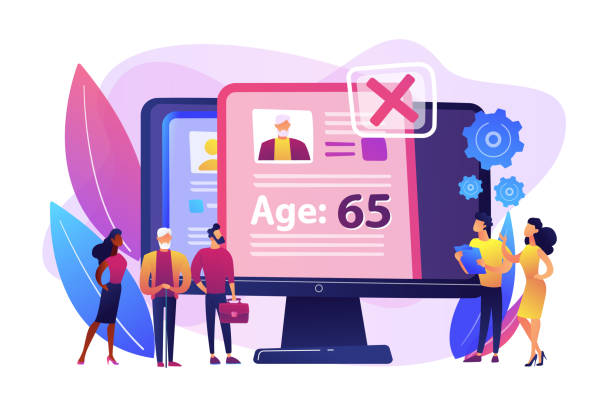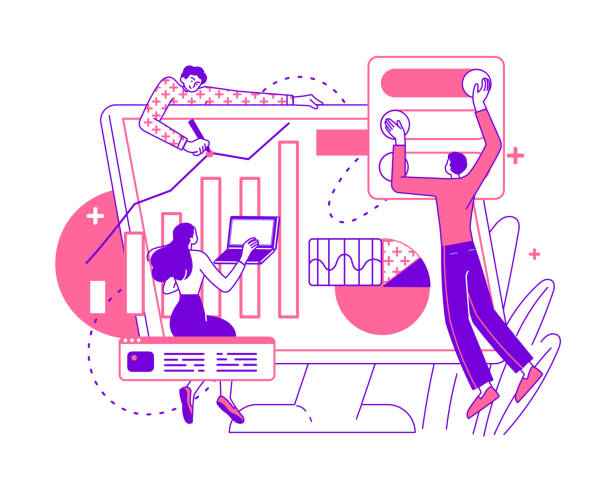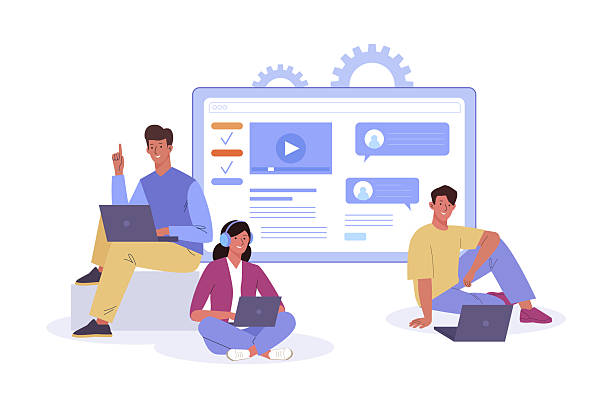Paramount Importance of Fast Website Design in Today’s World

#Website loading speed is a crucial factor in the online success of businesses in the current era.
In a world where users expect to obtain information in a fraction of a second, a slow-loading website simply loses its audience.
Studies have shown that every second of delay in page loading can lead to a significant decrease in conversion rates, reduced page views, and a drop in customer satisfaction.
For example, Amazon has reported that just 100 milliseconds of page load delay reduces their sales by 1%.
These statistics indicate that fast website design is not merely a competitive advantage, but a necessity for survival and growth in the digital space.
In addition to user experience (User Experience), site speed plays a pivotal role in Search Engine Optimization (SEO).
Google and other search engines consider website speed as an important factor in ranking search results.
Websites that load faster are more likely to rank higher in search results, which in turn means increased organic traffic and, ultimately, business growth.
The fundamental question is: Can your business afford the cost of losing customers and traffic opportunities due to a slow website? The answer is clear: No.
Therefore, investing in site speed optimization and implementing the principles of fast website design is not just an option, but a smart and vital strategy that will yield tangible results.
Is your online sales not as expected? With Rasawweb, solve the problem of low sales and poor user experience forever!
✅ Increase visitor-to-customer conversion rate
✅ Create an enjoyable user experience and increase customer trust
⚡ Act now to receive a free consultation!
Impact of Site Speed on Your Website’s User Experience and SEO

#The loading speed of your website pages is directly linked to your #user experience and your #position in search engines.
Today’s users are more impatient than ever; if your website doesn’t load in less than a few seconds, many of them will leave before even seeing your content.
This phenomenon, known as “Bounce Rate” (Bounce Rate), has increased and indicates user dissatisfaction.
Fast website design ensures that users spend more time on your site, visit more pages, and increases the likelihood of them taking your desired action, such as making a purchase or signing up.
A fast-loading website not only satisfies users but also significantly helps in building a professional and reliable image for your brand.
From an SEO perspective, search engines like Google prefer websites that offer a better user experience.
Loading speed is one of the Core Web Vitals that Google uses to evaluate page experience.
These metrics include Largest Contentful Paint (LCP), First Input Delay (FID), and Cumulative Layout Shift (CLS), all of which are directly affected by website speed and performance.
A website that performs poorly on these metrics may rank lower in search results, even if its content is of very high quality.
Therefore, to achieve high rankings in search results and increase organic traffic, website speed optimization is a fundamental step.
Investing in fast website design not only means increased user satisfaction but also directly leads to increased visibility of your website in search engines and ultimately the growth of your business.
Basic Principles and Key Steps in Site Speed Optimization

#Website speed optimization requires understanding several #key principles, by adhering to which faster #web page loading can be achieved.
The first step is to ensure clean and optimized coding.
Excess code, inefficient functions, or unnecessary plugins can significantly reduce site speed.
The second principle is using high-quality web hosting that provides fast and stable servers.
The third principle is optimizing images and media, which are often one of the biggest factors in site slowness.
High-volume images, without proper compression, can significantly increase loading time.
Practical steps for fast website design include: compressing CSS, JavaScript, and HTML files (Minification), using the Lazy Loading technique for images and videos that only load when needed, and implementing Caching to temporarily store data in the user’s browser.
Using a Content Delivery Network (CDN) can also significantly increase loading speed, as it delivers content from the server closest to the user.
Finally, regular updates of the Content Management System (CMS), themes, and plugins are also essential for maintaining security and speed optimization.
To better understand the impact of these optimizations, the table below provides a comparison of the impact of various website assets on loading time:
| Asset Type | Status | Approximate Impact on Loading Speed (%) | Optimization Solution |
|---|---|---|---|
| Images | Unoptimized | Up to 50% reduction | Compression, WebP format, Lazy Loading |
| Images | Optimized | 10-20% Increase | – |
| CSS/JS Codes | Uncompressed | Up to 20% reduction | Minification, Gzip Compression |
| CSS/JS Codes | Compressed | 5-10% Increase | – |
| Fonts | Inefficient | Up to 15% reduction | Compression, Preload, Remove unnecessary fonts |
Front-End Optimization for Faster Loading

#Front-end optimization is one of the #most important parts in achieving #fast website design, as this section directly interacts with the user’s browser and what they see.
One of the key principles is reducing the size of CSS and JavaScript files.
This is done through “Minification” which removes whitespace, comments, and extra characters from the code.
Additionally, “Concatenation” or combining multiple small CSS or JavaScript files into a larger one, can reduce the number of HTTP requests and consequently increase loading speed.
Also, Gzip compression should be enabled for all text files (HTML, CSS, JS) to reduce the volume of data transferred.
Another vital technique is eliminating Render-Blocking Resources.
This means that CSS and JavaScript files not essential for initial page rendering should be loaded asynchronously or moved to the end of the HTML document body.
Using “Critical CSS” is also an advanced method that places only the necessary CSS for displaying above-the-fold content at the beginning of the HTML, allowing the page to become visible quickly.
Finally, image optimization using modern formats like WebP, which have smaller file sizes and offer acceptable quality, and implementing “Lazy Loading” for all images and videos, significantly impacts front-end loading speed.
These collective measures ensure that your user experience is provided in the best possible way and you achieve the goals of fast website design.
Did you know that customers’ first impression of your company is your website? With a powerful corporate website from Rasawweb, multiply your business’s credibility!
✅ Custom and eye-catching design tailored to your brand
✅ Improve user experience and increase customer acquisition
⚡ Get a free consultation now!
Back-End and Server Optimization for High Performance

#Back-end and #server optimization is a vital foundation for #high website performance and achieving fast website design.
Even if your front-end is optimally designed, a slow back-end or inefficient server can render all efforts ineffective.
One of the key aspects in this section is database optimization.
Ensuring that database queries are efficient, have appropriate indexes, and unnecessary data is purged can significantly reduce server response time (Time To First Byte – TTFB).
Using caching techniques at the database level can also help.
Choosing appropriate hosting is also extremely important.
Inexpensive shared hosts often have limited resources and can lead to website sluggishness, especially during peak traffic.
Investing in dedicated hosting, VPS, or managed cloud services can provide sufficient resources and stability for a high-speed website.
Proper server configuration, such as using high-speed web servers (Nginx instead of Apache in some cases) and enabling Gzip compression at the server level for all text files, are other factors that help increase website loading speed.
Additionally, using a Content Delivery Network (CDN) to serve static files from the server closest to the user reduces the load on the main server and improves speed for users in different parts of the world.
This set of back-end measures forms the backbone of a fast and responsive website.
Image and Media Management and Optimization on Websites

#Images and #media are often the #biggest cause of slow loading on websites.
High-volume images without proper optimization can severely impact page load time and render your efforts for fast website design ineffective.
The first step in this regard is compressing images without noticeable quality loss.
Online tools and CMS plugins can help you reduce file sizes.
Also, choosing the right image format is crucial; for photos, JPEG with proper compression, and for graphics with transparency or images with a limited color palette, PNG is usually the best option.
In addition to compression, using next-generation image formats like WebP (developed by Google) and AVIF, can significantly reduce file sizes while maintaining visual quality.
These formats offer much more efficient compression than JPEG and PNG.
Another important point is setting the correct image dimensions; each image should be exactly the size it is displayed on the page, and avoid loading images larger than necessary.
Implementing Lazy Loading for all images and videos is a necessity.
This technique ensures that media only loads when the user scrolls to it, resulting in faster initial page loading.
For logos and icons, using vector graphics (SVG), which are scalable and have small file sizes, is also recommended.
By following these tips, you can ensure that images and media become assets for accelerating your website’s loading rather than obstacles, optimizing the user experience.
Utilizing Caching Systems to Boost Speed

#Caching is one of the #most powerful and #effective methods for achieving fast website design.
The main concept of caching is to temporarily store frequently used data so that in subsequent requests, instead of reprocessing or loading from the main server, they are retrieved directly from the cache memory.
This significantly reduces server response time and lessens the load on server resources.
There are different types of caching, each operating at a different layer of the website loading process, and collectively contributing to speed optimization.
Browser Caching stores static files (such as CSS, JavaScript, images) on the user’s device so that they don’t need to be downloaded again on subsequent visits.
Server-side Caching is implemented at various layers, including Page Cache, Object Cache, and Database Cache.
Page caching stores the entire HTML page, eliminating the need for PHP processing or database queries for each request.
Object caching stores database query results or complex calculations.
CDN Caching (Content Delivery Network Caching) also stores content on servers close to the user, which reduces latency and increases loading speed for users in distant geographical regions.
The table below provides a comparison between these caching methods and their benefits, which will help you in choosing and implementing the correct ones for fast website design:
| Caching Type | Storage Location | Type of Cached Content | Main Benefits |
|---|---|---|---|
| Browser (Browser Cache) | User Device | CSS, JS, Images, Fonts | High loading speed for recurring visits, reduced server load |
| Server (Server-side Cache) | Web Server | Full HTML pages, database query results | Reduced server response time, increased traffic capacity |
| Content Delivery Network (CDN Cache) | CDN servers worldwide | Static files, sometimes full pages | Reduced Latency for global users, load distribution |
Tools and Metrics for Website Performance and Speed Monitoring

#Continuous monitoring of #website performance is an integral part of the #fast website design process and maintaining its speed over time.
Without accurate measurement, you cannot know which optimizations have been effective and which areas still require attention.
Fortunately, powerful and free tools are available to help you measure your website’s speed, identify bottlenecks, and receive recommendations for improvement.
One of the most popular of these tools is Google PageSpeed Insights, which not only provides a score for desktop and mobile performance but also gives you a detailed report on Core Web Vitals metrics and optimization opportunities.
Other tools such as GTmetrix and Lighthouse (built into Chrome’s developer tools), also provide more comprehensive and specialized reports, including Waterfall Charts, which allow you to view individual HTTP requests and their loading times.
This data is invaluable for identifying slow files, heavy scripts, or external resources that impact site performance.
Key metrics to pay attention to include: Time to First Byte (TTFB), First Contentful Paint (FCP), Largest Contentful Paint (LCP), First Input Delay (FID), and Cumulative Layout Shift (CLS).
Correct interpretation of these results and acting on the recommendations provided by these tools will assist you in the path of continuous website speed improvement and maintaining a fast website design.
These monitoring checks should be performed periodically and after any major changes to the website to ensure performance stability.
Tired of your company’s website not being seen as it deserves, and losing potential customers? Solve this problem forever with professional and effective website design by Rasawweb!
✅ Increase brand credibility and gain customer trust
✅ Attract targeted sales leads
⚡ Contact us now for a free consultation!
Common Mistakes in Web Design and Solutions to Avoid Them

#Fast website design is a goal that many web designers and developers pursue, but there are #common mistakes that can undermine this goal.
One of the biggest of these mistakes is not optimizing images and media.
Loading large-sized images without proper compression can easily add tens of megabytes to the page size and drastically increase loading time.
The solution is to use compression tools, modern formats like WebP, and implement Lazy Loading.
Another mistake is excessive increase in JavaScript and CSS codes and not compressing or minifying them.
These large and scattered files increase the number of HTTP requests and become render-blocking.
Excessive use of plugins and add-ons, especially in CMSs like WordPress, can severely reduce site speed.
Each plugin adds extra code and new HTTP requests to the site, which can lead to conflicts and reduced performance.
The solution is to install only essential and high-quality plugins and update them regularly.
Choosing unsuitable and cheap hosting is another factor for slowness.
Shared hosts with limited resources are not suitable for high-traffic or complex websites.
Investing in quality and optimized hosting for fast website design is essential.
Furthermore, not utilizing caching and CDN misses a great opportunity to increase speed.
By avoiding these mistakes and focusing on optimization principles, one can achieve a fast and efficient website that is attractive to both users and search engines.
Future Trends and Continuous Maintenance for Sustaining Site Speed

#Fast website design is not a #one-time project, but a #continuous process requiring maintenance.
As web technology advances, new trends emerge that can increasingly impact website speed and performance.
One of these important trends is HTTP/3, which, by using the QUIC protocol, provides faster and more secure connections and is specifically optimized for high packet-loss network environments.
Wider adoption of this protocol can be a significant step in improving website loading speeds.
Additionally, using more advanced compressions like Brotli instead of Gzip can further reduce file sizes.
Furthermore, Progressive Web Apps (PWA), which combine the best features of web and mobile applications, help enhance user experience with capabilities such as offline functionality and fast loading.
Serverless architectures also contribute to scalability and faster responsiveness by eliminating the need for server management and paying only based on consumption.
To maintain a fast website design, regular maintenance is essential.
This includes continuous updates of the Content Management System (CMS), themes, and plugins, which not only ensures security but also allows you to benefit from new performance optimizations.
Continuous speed monitoring using the introduced tools, resolving performance issues as soon as they are identified, and adapting to the latest web standards and technologies are key to long-term success in the digital space.
Frequently Asked Questions
| Row | Question | Answer |
|---|---|---|
| 1 | What does fast website design mean? | Fast website design means optimizing the website design and development processes so that the final result (the website) is ready for operation in the shortest possible time, while maintaining quality and efficiency. This includes the use of efficient tools, templates, and techniques. |
| 2 | Why is speed important in website design? | Speed in website design is important because customers usually have an immediate need for an online presence. Also, longer projects can be more costly and delay business opportunities. Delivering a website faster contributes to customer satisfaction and competitive advantage. |
| 3 | What tools help with fast website design? | Content Management Systems (CMS) like WordPress, Joomla, or Drupal, the use of CSS frameworks like Bootstrap or Tailwind CSS, Page Builders like Elementor or Visual Composer, and Rapid Application Development (RAD) tools help with fast design. |
| 4 | Does using ready-made templates affect fast design? | Yes, using ready-made and standard templates has a significant impact on fast design. These templates are pre-designed and only require customization of content, color schemes, and images, which drastically reduces development time. |
| 5 | What is the role of CMS (Content Management System) in fast website design? | CMSs play a key role in accelerating the website design and development process due to providing a graphical user interface, eliminating the need for deep coding for most operations, the availability of ready-made plugins and templates, and easy content editing capabilities. |
| 6 | Does high design speed reduce the final quality of the website? | Not necessarily. If standard and optimized methods, tools, and templates are used, a high-quality website can be designed in a short time. The knowledge and experience of the design team are also very effective in maintaining quality. |
| 7 | What tips are important for accelerating the customer communication process in website design? | Having a clear and defined process for gathering requirements, using standard forms for content submission, setting realistic deadlines, and holding focused and efficient meetings can accelerate customer communication. |
| 8 | What impact does image optimization have on website loading speed after design? | Image optimization (volume compression, use of appropriate formats like WebP) reduces the overall size of website pages. This reduction in size helps browsers download and display pages faster, which improves user experience. |
| 9 | Is appropriate hosting effective in the final speed of the website after design? | Yes, high-quality hosting, powerful servers, sufficient resources, and adequate bandwidth play a very important role in website loading speed after design. Even an optimized website will perform slowly on weak hosting. |
| 10 | For what type of businesses is fast website design most suitable? | Fast website design is highly suitable for small and medium-sized businesses, startups, nascent online stores, bloggers, or individuals who need an immediate and low-cost online presence. This method allows them to enter the market faster and receive feedback. |
And other advertising services of Rasawweb Advertising Agency
Best timing for advertorial publication on classified ad websites
How to attract target customers with advertorials
Creating storytelling in advertorials to attract audience attention
Benefits of advertorials for introducing new office technologies
How to showcase the value of your products with advertorials
And over hundreds of other services in the field of internet advertising, advertising consultation, and organizational solutions
Internet Advertising | Advertising Strategy | Advertorial
🚀 To enable your business to reach its peak in the digital world and have a powerful and impactful presence, Rasawweb Afarin Digital Marketing Agency, specializing in key areas such as user-friendly website design, Search Engine Optimization (SEO), and targeted advertising campaigns, smooths your path to growth.
📍 Tehran, Mirdamad Street, next to Central Bank, Southern Kazeroun Alley, Ramin Alley, No. 6

